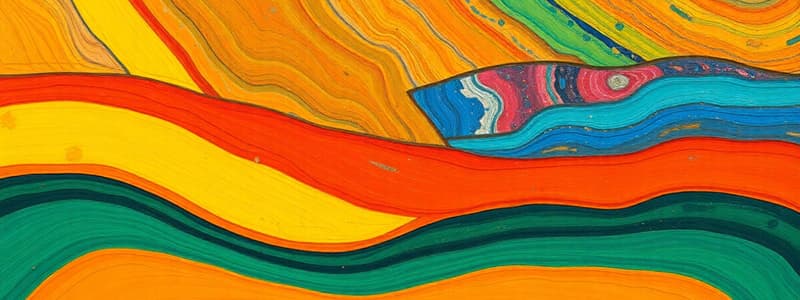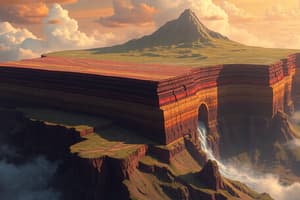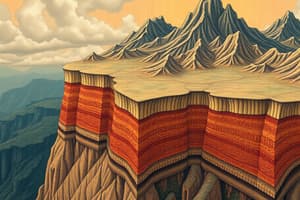Podcast
Questions and Answers
Which layer of the Earth is the hottest and innermost?
Which layer of the Earth is the hottest and innermost?
- Core (correct)
- Crust
- Mantle
- Lithosphere
What geological feature is formed where tectonic plates converge?
What geological feature is formed where tectonic plates converge?
- Subduction zone (correct)
- Transform fault
- Mid-ocean ridge
- Rift valley
According to the theory of plate tectonics, what describes the Earth's surface?
According to the theory of plate tectonics, what describes the Earth's surface?
- Divided into several constantly moving plates (correct)
- Primarily liquid with scattered solid islands
- A single, unbroken landmass
- Static and unchanging over time
Which of the following is considered a primary earthquake hazard?
Which of the following is considered a primary earthquake hazard?
What is the main purpose of an earthquake hazard map?
What is the main purpose of an earthquake hazard map?
What immediate action should you take if you are indoors during an earthquake?
What immediate action should you take if you are indoors during an earthquake?
What should you do immediately after an earthquake?
What should you do immediately after an earthquake?
What does the intensity of an earthquake measure?
What does the intensity of an earthquake measure?
What is the function of securing heavy objects to walls before an earthquake?
What is the function of securing heavy objects to walls before an earthquake?
Which of the following best describes the lithosphere?
Which of the following best describes the lithosphere?
What is the significance of understanding plate movements in earthquake preparedness?
What is the significance of understanding plate movements in earthquake preparedness?
Which scientist developed the Mercalli Intensity Scale?
Which scientist developed the Mercalli Intensity Scale?
What should you include in an emergency kit in preparation for an earthquake?
What should you include in an emergency kit in preparation for an earthquake?
What makes the asthenosphere different from the lithosphere?
What makes the asthenosphere different from the lithosphere?
Which of these is NOT a recommended safety measure to take during an earthquake if you are outdoors?
Which of these is NOT a recommended safety measure to take during an earthquake if you are outdoors?
What does the Richter scale measure?
What does the Richter scale measure?
In the late 20th century, what scale was developed to measure an earthquake's size?
In the late 20th century, what scale was developed to measure an earthquake's size?
If you are in a vehicle during an earthquake, what is the safest course of action?
If you are in a vehicle during an earthquake, what is the safest course of action?
What is the primary reason for turning off utilities (gas, electricity, water) after an earthquake?
What is the primary reason for turning off utilities (gas, electricity, water) after an earthquake?
Imagine a scenario where you are advising a team of structural engineers on designing a building in a region known for frequent earthquakes. Considering the principles of earthquake-resistant design derived from the study of plate tectonics and seismic activity, which innovative, yet highly expensive method, would offer the MOST comprehensive protection against seismic forces, even though its complexity and cost make it rarely used in standard construction?
Imagine a scenario where you are advising a team of structural engineers on designing a building in a region known for frequent earthquakes. Considering the principles of earthquake-resistant design derived from the study of plate tectonics and seismic activity, which innovative, yet highly expensive method, would offer the MOST comprehensive protection against seismic forces, even though its complexity and cost make it rarely used in standard construction?
Flashcards
Core
Core
The hottest and innermost layer of the Earth.
Mantle
Mantle
The thick, second layer of the Earth, surrounding the core.
Crust
Crust
The thin, outermost solid layer of the Earth, covering the mantle.
Asthenosphere
Asthenosphere
Signup and view all the flashcards
Lithosphere
Lithosphere
Signup and view all the flashcards
Plate Tectonics
Plate Tectonics
Signup and view all the flashcards
Subduction zones
Subduction zones
Signup and view all the flashcards
Earthquake
Earthquake
Signup and view all the flashcards
Earthquake hazard
Earthquake hazard
Signup and view all the flashcards
Primary earthquake hazards
Primary earthquake hazards
Signup and view all the flashcards
Secondary earthquake hazards
Secondary earthquake hazards
Signup and view all the flashcards
Intensity
Intensity
Signup and view all the flashcards
Magnitude
Magnitude
Signup and view all the flashcards
Mercalli Intensity Scale
Mercalli Intensity Scale
Signup and view all the flashcards
Richter Magnitude Scale
Richter Magnitude Scale
Signup and view all the flashcards
Hazard map
Hazard map
Signup and view all the flashcards
Know Your Risk
Know Your Risk
Signup and view all the flashcards
Secure Heavy Objects
Secure Heavy Objects
Signup and view all the flashcards
Emergency Kit
Emergency Kit
Signup and view all the flashcards
Develop an Emergency Plan
Develop an Emergency Plan
Signup and view all the flashcards
Study Notes
- The Earth's highest and deepest points were formed by plate movements
- The lesson objectives are to understand plate movements, identify earthquake hazards, recognize tsunami signs, analyze effects, interpret hazard maps, and apply safety measures
- The Earth is composed of the core, mantle, and crust
Earth Layers
- The core is the Earth's hottest, innermost layer
- The mantle is the thick second layer
- The crust is the thinner layer covering the mantle
Asthenosphere and Lithosphere
- Asthenosphere: The hotter and more easily deformed inner layer
- Lithosphere: The outer layer composed of large blocks called tectonic plates
Plate Tectonics Theory
- The Earth is divided into plates.
- Plates are like slabs on the surface of the Earth's shell or lithosphere
- All land and water sit on these plates
- Plates are constantly in motion
- Earth's plates move around the surface at a rate of a few centimeters every year
Subduction Zones
- Subduction zones are areas where tectonic plates converge
Earthquake
- Earthquake: Perceptible shaking of the Earth's surface from a sudden energy release in the crust creating seismic waves
- Source: United States Geological Science (USGS)
Earthquake Hazards
- Earthquake hazard: Potential dangers and destructive effects caused by earthquakes
Primary Earthquake Hazards
- Ground shaking
- Landslides
- Liquefaction
- Surface rupture
Secondary Earthquake Hazards
- Tsunami
- Seiche
- Flooding
- Fire
Intensity and Magnitude of an Earthquake
- Intensity: Perceived strength based on the earthquake's relative effect on people and structures
- Magnitude: Based on instrumentally derived information correlated with total energy released at the earthquake's origin
Earthquake Measurement Scales
- Mercalli Intensity Scale: Developed by Giuseppe Mercalli in 1902
- Richter Magnitude Scale: Developed by Charles F. Richter in 1935
- Moment Magnitude Scale: Developed in the late 20th century
Hazard Maps
- Hazard map: A visual representation of areas at risk from natural hazards
Earthquake Preparedness Measures
- Know Your Risk: Check earthquake hazard maps to understand your area's risk level
- Secure Heavy Objects: Bolt furniture, shelves, and heavy appliances to walls
- Create an Emergency Kit: Include water, food, first aid supplies, flashlight, batteries, and important documents
- Develop an Emergency Plan: Discuss safe exits, meeting points, and communication plans with family members
- Reinforce Buildings: Strengthen your home or workplace to make it more earthquake-resistant
- Identify Safe Spots: Find sturdy furniture (like tables) or interior walls to take cover under
- Participate in Drills: Practice "Drop, Cover, and Hold On" regularly
Response Measures During an Earthquake
- If Indoors: Drop, Cover, and Hold On
- Get down, take cover under a sturdy table, and hold on
- Stay Indoors: Move away from windows, glass, and objects that could fall
- Avoid Doorways: Door frames are not the safest place; protect yourself under a strong table
- If Outdoors: Move to an Open Area and stay away from buildings, trees, streetlights, and power lines
- Drop to the Ground and stay low, protecting your head from falling debris
- If in a Vehicle: Pull Over Safely and stop in a clear area away from bridges, overpasses, and buildings
- Stay Inside the Vehicle and wait until the shaking stops before driving carefully
Recovery Measures After an Earthquake
- Check for Injuries and administer first aid if needed, and call for emergency help
- Inspect for Hazards: Look for structural damage, gas leaks, and electrical issues
- Turn Off Utilities if Necessary and shut off gas, electricity, and water if there are leaks or damage
- Be Aware of Aftershocks because smaller quakes may follow, stay alert and take cover if needed
- Follow Official Updates and listen to emergency broadcasts and obey evacuation orders if given
- Stay Away from Damaged Areas and don't enter unstable buildings or areas prone to landslides
- Help Others: Assist neighbors, especially children, elderly, and injured individuals
Studying That Suits You
Use AI to generate personalized quizzes and flashcards to suit your learning preferences.




